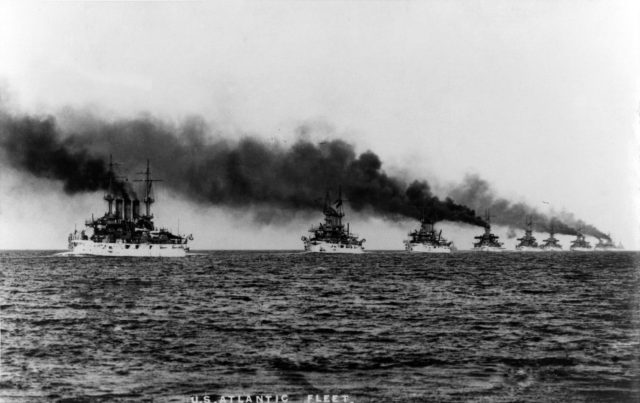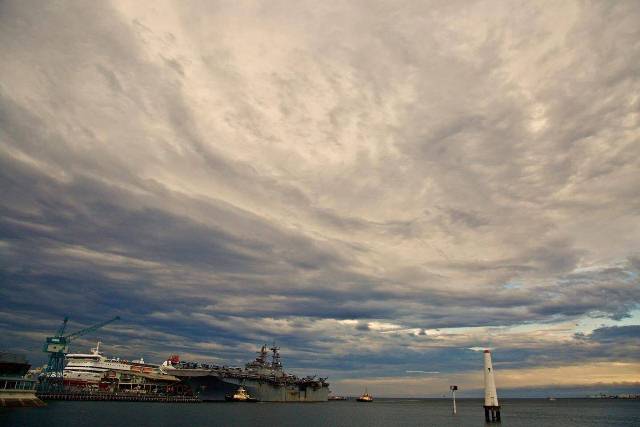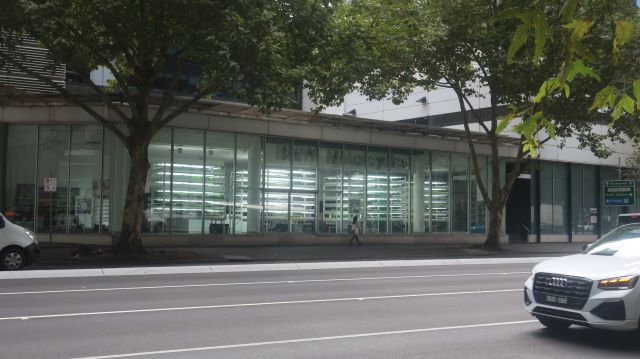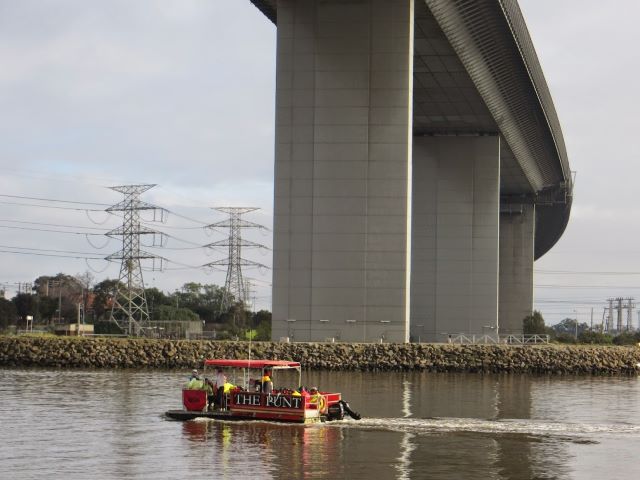
US Navy in Port
The amphibious assault ship USS Bonhomme Richard (LHD 6) spent six days in Port from August 28 after training exercises in our region to enhance ‘warfighting readiness’ and to prepare for any contingency.
Over the week I spent some time around Station Pier, looking at the ship in the company of strangers. People came and went, witnessing the visit with selfies. There was a mildly festive mood. A police vessel maintained a discreet presence around the beacon. Few people seemed to share the disquiet I felt about the escalating tension arising from North Korea’s missile testing. While in Port, the USS BHR monitored the situation in North Korea.
Its size – 235m long – was as obvious a topic of conversation as the bitterly cold weather. The ship occupied nearly the entire inner east berth of Station Pier. On the deck of the vast grey ship were the Ospreys that take off like a helicopter but fly like an aeroplane.
I sat in the café among the conversation of sailors and marines – mostly men but some women too. They were very young – like those soldiers we commemorate enlisting for World War 1, drinking pepsi (not coke) and checking their phones. Over 1,000 personnel, casually dressed, dispersed around Melbourne for shore leave.
Earlier in August, the USS Bonhomme Richard had been engaged in joint training exercises with the Australian Navy during which three US personnel died in what is referred to as a ‘mishap’ off Shoalwater Bay near Rockhampton.
The unwieldy ship needed two tugs to turn it round to leave Station Pier. It had no thrusters of its own, I was told.
The ship visit prompted reflections on the history of Australia’s relationship with America as it has played out in Port Melbourne and how to ‘make sense of our disturbing present’.2
The Australian Federation was newly formed when Prime Minister Alfred Deakin invited President Roosevelt to send the expanded American fleet to visit Australian ports on their circumnavigation of the world. This was a challenge to Britain, but since Britain had withdrawn its ships from the Pacific following Russia’s defeat by Japan, Australia felt isolated and exposed.
Sixteen gleaming white ships with gold trim (though spewing coal smoke) steamed into Melbourne on 29 August 1908. I don’t think that this significant anniversary was picked up by the media.
Port Melbourne was proud and Melbourne turned itself inside out to welcome the 14,000 sailors and marines in days of celebration.
“Last Saturday was no doubt one of the greatest days in the history of Port Melbourne, and proved once again that whatever the desire of those in high places to treat this town with contempt, the general public recognise that it is a favourite place of resort, when anything of interest in the maritime world stirs the great heart of the people.”1
The visit of the Great White Fleet grew popular support for the formation of an Australian Navy. Finally founded in 1911, one its first buildings was the Naval Drill Hall in Bay Street (now part of the Albert Park College campus).
In early 1942, Australia was once again exposed and vulnerable. The urgent challenges of the War in Europe took precedence over the defence of Australia for Churchill. A Japanese invasion was widely anticipated and feared, particularly in Port Melbourne and surrounding suburbs because of the nature of the industries located here. It was in this context that the Battle of the Coral Sea (4 – 8 May) between the Japanese and American Navies came to assume such significance as it interrupted the Japanese advance southward.
During the second War, Port Melbourne was alive with the presence of the US Army. Soldiers camped out at the Port Melbourne Football Ground, huge supply sheds lined what we know today as Sandridge Beach and the new industries of Fishermans Bend cranked out food and equipment to supply them.
Returning to the present
On the sixth day the USS Bonhomme Richard departed from Station Pier and North Korea conducted its sixth and largest nuclear bomb test.
With America’s chaotic, erratic and bellicose leadership, its isolationist preference and a thin relationship between President Trump and Prime Minister Turnbull, the historic alliance does not seem very dependable.
I close this post with this photograph which expresses something different from the very many photos taken during the ship’s visit. Even though the USS Bonhomme Richard was so huge close up, America’s power and influence in our region is diminished and we have good cause to reflect again on our vulnerability.
More
1 M and G Bride The Borough and Its People: Port Melbourne 1839 to 1939, p239
2 Tom Griffiths 2017 Ernest Scott Prize/ History Council of Victoria, 5 September 2017
Public Record Office of Victoria Great White Fleet – 105 years on
Dr David Stephens The Great White Fleet’s 1908 visit to Australia Royal Australian Navy
USS Bonhomme Richard on facebook






Leave a Reply